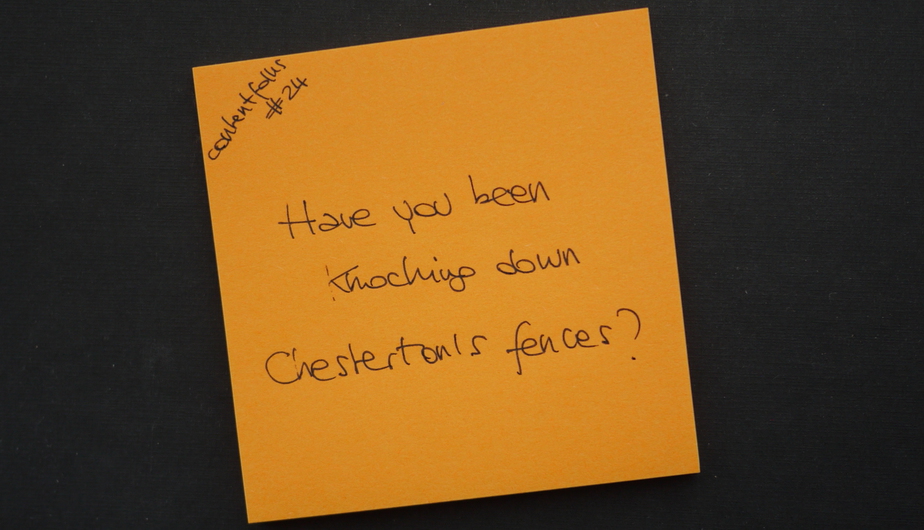
Welcome to contentfolks—a fortnightly newsletter with short lessons & ideas about content that makes a difference, sparks action, and truly serves its audience. Thank you for being here!
Hey 👋
Have you heard of “Chesterton’s fence?” It’s a principle inspired by a book published almost 100 years ago, in which G. K. Chesterton wrote:
“Let us say [… you find] a fence or gate erected across a road. The more modern type of reformer goes gaily up to it and says, ‘I don’t see the use of this; let us clear it away.’ To which the more intelligent type of reformer will do well to answer: ‘If you don’t see the use of it, I certainly won’t let you clear it away. Go away and think. Then, when you can come back and tell me that you do see the use of it, I may allow you to destroy it.’”
According to the principle of Chesterton’s fence, when facing an existing system you shouldn’t make changes until you understand why it’s there in the first place. This idea has wide-ranging practical applications; for example, Wikipedia’s editors use it as one of their heuristics when deciding whether to nominate something for deletion:

The Chesterton fences you encounter in content marketing
Working in content marketing, you come into contact with fences all the time. Some are small, like content pieces or website pages that pre-date you; some are large, like tools you inherit from previous teammates or processes that were put in place before you showed up.
Regardless of their size, these fences often feel like they’re there for no good reason and should be removed. Which, by the way, might well be what you end up doing—Chesterton’s principle doesn’t suggest you should forever maintain the status quo; mostly, it reminds you that before making any decision about a (content) fence, you have to investigate why it’s there.
A practical example of what NOT to do
A few months back, I worked on the information architecture of Aula’s Help Centre to plan a new content section. At some point, I stumbled upon a bunch of pages that seemed to be there for no good reason: they looked old and there wasn’t a clear way for people to reach them from within the Help Centre, so I went ahead and clicked ‘unpublish’ (sigh).
Of course, that was the wrong move: at least one of the pages I unpublished was part of an existing Customer Support flow. No, there wasn’t an obvious way to reach it from within the Help Centre—and that’s because folks in the CS team just share the link via email whenever a customer needs it.
It wasn’t a big deal and I re-published the page as soon as somebody noticed, but that’s a common fence you will encounter as a content marketer: an old piece of content whose purpose is invisible to you… and very clear to others.
A practical example of what to do
Another situation where you may find yourself surrounded by fences is during your first weeks in a new job or team, especially if you come in at a senior level and/or have the power to enact change. Existing tools and software, contractors and agencies, internal processes, team rituals, content strategy: everything can look like a fence when you’re new and want to feel that you own whatever you have inherited.
I know the feeling, because I started a new job last month and I’ve had to remind myself multiple times not to tear down any fences until I’ve figured out why they are there. If you find yourself in the same spot, these questions can help guide your decision-making process:
- Why is this [content piece, process, tool, external partner, agency, etc.] here?
- Who was in charge of putting it here?
- When’s the last time we used it?
- What problems did it solve?
- What new problems could it cause if I removed it?
So there you have it: fences. Who knew? The next time you find yourself in front of one, metaphorical or otherwise, remember that the smartest move is not tearing it down: it’s getting to the bottom of why it’s there, and using that information to plan your next move.


